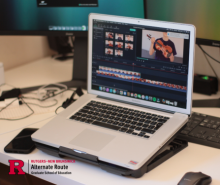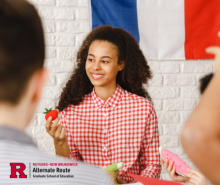5 Engagement Strategies Math Teachers Can Use to Reach Different Learning Styles

Student engagement refers to the level of attention and interest that students exhibit when they are being taught. In the classroom, no matter what subject or grade level you teach, you will always have a wide variety of learners. There are many different ways students learn, the three main categories are visual learning, auditory learning, and kinesthetic learning. It is important for teachers to not just be able to teach all students regardless of their learning style, but to teach them all within the same class. It is for this reason that teachers need to develop strategies and acquire tools to better equip them to help every student reach their full potential.
Engaging students of all learning styles is not always easy, but it is important. By using a variety of teaching methods, technology tools, and freedom, you can create a learning environment that is engaging and effective for all students.
Understanding Students as Individuals
Teachers should encourage dialogue and get to know the students to overcome cultural and linguistic barriers. Establish a connection with students by understanding their needs and interests. It is also important to use diverse teaching approaches that emphasize different learning preferences.
In order to find tools of engagement, it is important to take a step back and ask what the current issues are that are preventing student engagement. This issue is addressed in a research article called “The Role of Educational Communication in Promoting a Student-Centered Learning Style in Multicultural Classrooms: A Reflective Essay on Learning and Teaching in Higher Education” (AlAhmad, 2021) in the International Journal of Research in Education and Science.
In the article, the author discusses some of the issues hindering student engagement. The first solution discussed to help promote student engagement is to get past the cultural and linguistic barriers that exist within the class by encouraging dialogue and getting to know the students. Student engagement increases if the teacher understands the students as individuals with lives outside the classroom. When this happens, the students feel more comfortable and open up. The research done referenced Maslow and how knowing students’ needs establish “on how and to what extent an educational communication model/technique can be effective in engaging our students” (AlAhmad, 844).
The article also discusses using diverse teaching approaches to emphasize diverse learning preferences. Specifically, the author says to try “starting a dialogue stimulated by questions that link to their previous knowledge, accompanied by body language, smiles and leading hints. I also sought to motivate students’ critical and reflective participation to overcome the persistent degree of reluctance” (AlAhmad, 843) and to remind students that wrong answers are good for starting the conversation and helping the class connect thoughts as a whole. 
Utilizing Mathematical Representations
Consider using and connecting mathematical representations to deepen conceptual understanding. Also, display and elaborate on the connections between different representations.
An excerpt from the National Council of Teachers of Mathematics recently addressed the idea of different learning styles. In the excerpt, it discusses multiple practices that are effective in teaching mathematics. The excerpt discusses a technique that is specific to mathematics which is to use and connect mathematical representations. What this means is to engage students in making connections among mathematical representations. Not only should teachers use multiple representations, but they should display and elaborate on the connections between them to deepen the conceptual understanding and procedures so they can be used as tools for problem-solving, both by students and teachers.
R2D2 Method for Virtual Learning
Use the R2D2 Method (Read, Reflect, Display, Do) to cater to different learning styles in virtual classrooms. In addition, provide resources such as blogs, vlogs, podcasts, etc. to reach a wide range of learners.
In recent years the world has dealt with the pandemic related to Covid-19. Teachers were forced to teach virtually, and this opened up a whole new challenge, but also new opportunities. The teacher toolbox needed to widen because of it. When trying to deal with different learning styles, teachers can use what is called the R2D2 Method, which was created by Dr. Curt Bonk.
R2D2 stands for Read (auditory and visual learners), Reflect (reflective learners), Display (visual learners) and Do (tactile, kinesthetic, and exploratory learners). Essentially, it uses resources such as blogs, vlogs, podcasts, etc. to reach a wide range of learning styles. Bonk even discusses how within the model there is room for creativity and innovation. Students can find video clips or other resources to use in class.
Technological Tools
Utilize online tools like Kahoot and Nearpod to create interactive lessons. Also, explore a variety of online resources and tools to address different learning styles.
In today’s day and age, technology is being integrated into just about everything, including education. Teachers are constantly finding new pieces of technology to use within the classroom to try to increase student engagement for all learning styles. In the article "7 Student Engagement Tools for Deeper Learning in Your Classroom” they discuss multiple technological tools teachers can use in the classroom. Whether you use review games like Kahoot or Nearpod to create interactive lessons, there is an endless number of tools accessible to teachers with all the technological advancements in society. Utilizing these online tools will help teachers reach the diverse learners that they encounter. The important thing is to utilize a variety of online resources and tools and stick to only one. Sticking to only one or two online tools will not benefit the different learning styles because each tool addresses certain learning styles.
Freedom and Flexibility
Provide a variety of ways for students to learn and let them find the best way for themselves. In addition, create a safe learning environment that allows for individualized learning and maximum engagement.
The last and simplest technique teachers should use to address the engagement of different learning styles is freedom. Teachers should not confine students to a specific way of learning concepts or put limitations on time. As a teacher, provide a variety of ways for students to learn and let them find the best way for themselves because allowing students to do this creates a safe learning environment predicated on success for everybody and maximum engagement. The education system is not perfect and has a lot of work to do, especially with an ever-changing society.
Engaging students of all learning styles is not always easy, but it is important. By using a variety of teaching methods, technology tools, and freedom, you can create a learning environment that is engaging and effective for all students. Every student is unique, and a combination of approaches may be necessary to cater to their individual needs and help them succeed.

AlAhmad, H. (2021). The Role of Educational Communication in Promoting a Student-Centered Learning Style in Multicultural Classrooms: A Reflective Essay on Learning and Teaching in Higher Education. International Journal of Research in Education and Science, 7(3), 838–851.
If you’re considering following your dream of teaching, Rutgers Alternate Route can offer you the support and training you need to succeed. Be sure to follow Rutgers Alternate Route on Twitter and sign up for Alternate Route’s monthly newsletter for more information and stories from the field of education.







